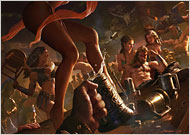Mister postman look and see/You got a letter in your bag for me
 Yes, Art Scatter DOES get mail. Most excellent mail, thank you very much. For example, Scott Wayne Indiana sent us a key. Well, not exactly a key (“this is not a key”), but an image of a key. You can see at the left, right? And can you make out what it says? “Do not duplicate.” And what did we do? Just moments ago with a couple of clicks? Mr. Indiana waved the red flag right in front of us, and we couldn’t resist. Anyway, we like Mr. Indiana’s impulses, so we are not obeying the key, and we pass along his invitation to further disobedience. At his website, Mr. Indiana explains how.
Yes, Art Scatter DOES get mail. Most excellent mail, thank you very much. For example, Scott Wayne Indiana sent us a key. Well, not exactly a key (“this is not a key”), but an image of a key. You can see at the left, right? And can you make out what it says? “Do not duplicate.” And what did we do? Just moments ago with a couple of clicks? Mr. Indiana waved the red flag right in front of us, and we couldn’t resist. Anyway, we like Mr. Indiana’s impulses, so we are not obeying the key, and we pass along his invitation to further disobedience. At his website, Mr. Indiana explains how.
We also received a note from Jeff Jahn at Portlandart.net, which he says is now in it’s third year. Art Scatter feels your pain, Mr. Jahn. Three years on the WWW must feel like … well, we could only imagine because we’re only four months in and that feels like… well, we have no idea. Anyway, he directed our attention to two interviews, one with LA art master Ed Ruscha and one with photographer Justine Kurland, and he was absolutely right. It was smart of Arcy Douglass to ask Ruscha about his use of diagonals in his work, and his answer, it has to do with trains (which will be coming up in a relativity post in August — trains, I mean!), was excellent. And Ryan Pierce’s take on Kurland is long and digressive and deep. She’s going to be a great addition to the art world here.
We’ve gotten two recent notes from Alyssa Rosso at the Tacoma Art Museum, which we admit to thinking is a pretty terrific museum, especially in its coddling of Northwest artists. The first is a call for submissions to the museum’s 9th Northwest Biennial. The deadline for you artists out there is July 26, and you have to work through some special entry site. We recommend going to the museum’s website and figuring out things from there. Alison de Lima Greene, cuurator of Contemporary Art and Special Projects at the Museum of Fine Arts, Houston, will be helping the museum’s Rock Hushka sort through the entries. Good luck! The second email simply lists the museum’s fall shows: recent acquisitions of a surrealist bent (including work by Salvador Dali and such Northwest artists as Morris Graves, Claudia Fitch, Anya Kivarkis, and Karen Willenbrink-Johnson); a Donald Fels collaboration with sign painters in India (which couldn’t sound more interesting); and the responses of Western artists to the Ottoman Empire. Hey, see you in Tacoma!
Finally, Art Scatter has made some very wise purchases at the Studio 333 open house before. Very wise indeed. It’s now called the Boxlift Building, but the artists, and we counted 15, are still conducting the open house. The details: 5 to 10 p.m., Saturday, June 14, 333 NE Hancock St and MLK Blvd. (with a music, wine and hors d’oeuvre reception). And thanks to Boxlift for letting us know about it!








